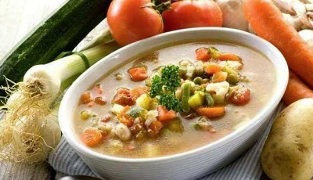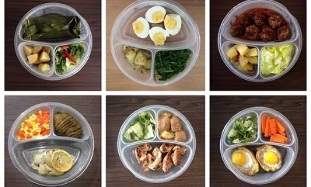
Inflammation of the stomach wall is uncomfortable and painful.
In addition to medication, diet is also important for gastritis and gastritis-the "right" product does not stimulate the stomach wall, does not promote the regeneration of the epithelium and keep the disease in relief.
What to eat for gastritis
There are many reasons for the development of gastritis:
- The diet is incorrect, mainly dry, spicy and hot food;
- Unbalanced diet;
- Abuse of alcoholic beverages, soda water;
- Take certain drugs that irritate the stomach wall
Before talking about what you can eat with gastritis and what you should reject, you need to understand some basic dietary assumptions:
- Meals should be taken regularly. You should not take a long break between meals, miss lunch or afternoon tea for any reason, and should not replace it with a "double" dinner;
- For gastritis, it shows small meals-small portions at short intervals;
- If possible, do not mix solid and liquid foods. The first course should be separated from the second course. Liquid or puree dishes are the easiest to digest.
- The temperature of the food should not be too high or too low. Warm food can be best absorbed without irritating the stomach;
- The use of edible salt should be minimized, and seasonings and spices should be completely abandoned;
- The diet should be rich in vitamins, but for gastritis patients, fiber is too heavy.
- Cook (steam) or stew dishes;
What can you eat for gastritis
High acidity
The purpose of the gastritis diet with increased gastric acid secretion is to reduce acidity and neutralize it with the help of stomach contents.
- Vegetable soup with pasta and rice. Boil the vegetables and pass through a blender.
- noodles or re-boiled cereal milk soup;
- Yesterday's (dry) white bread made from wheat flour;
- Meat-beef, lean lamb and pork, chicken, turkey, skinless rabbit, tendon. Meat can be roasted or steamed, thinly sliced meatloaf, souffle, meatballs, stroganoff beef (cooked meat);
- Milk and non-acid products, including kefir, yogurt, cream, sour cream, cheese (cheese cake, casserole), mild cheese varieties;
- Chicken, duck, quail eggs-soft boiled or omelet form;
- Vegetables-boiled or stewed, mashed. Pumpkin, squash, potatoes, beets, carrots, broccoli, tomatoes and peas are rarely allowed;
- Fruits-neutral or sweet, bananas, peeled apples (roasted), pears, ripe persimmons. Berries-just the sweetness of jelly, compote, fruit juice, marshmallow, marshmallow, jam, jam;
- As a cold food, you can drink boiled tongue, liver pate, fish jelly, red caviar, milk sausage and doctor's sausage, fudge, unsalted ham (in moderation! );
- It is recommended to drink sweet preserves, light tea (with milk, cream), weak coffee with milk, cocoa, jelly;
- Unsalted butter, ghee and refined vegetable oil are allowed.
Low acidity
At the time of diagnosis, the goal is to stimulate the production of hydrochloric acid. Unlike the previous diet, in this case, you can:
- Use steep fish and broth to cook soup;
- Eat sour vegetables and fruits;
- Include salted canned food in your diet;
- prefer fermented milk products;
- Drink sour juice-orange, grapefruit, tomato, grape;
- Drink mineral water
What not to eat for gastritis
High acidity

- Meat and fish broth, mushroom soup, cabbage soup, borscht, Oklaska soup cooked;
- Fresh bread, pastries, pastries, pastries, rye bread and rye flour products;
- Fatty meat, poultry, smoked products;
- Fat and salted fish, canned fish;
- Yogurt products, spicy cheese;
- Fried and hard-boiled eggs;
- Millet, barley, pearl barley, polenta;
- Pasta, except noodles;
- Beans, cabbage, kohlrabi, radish, sorrel, cucumber, spinach, onion; any vegetable in the form of pickled, pickled, canned pickled; mushrooms;
- Sour fruit-melon, pomegranate, grape, peach, citrus fruit, kiwi. The small seeds of the berries stimulate the intestinal wall and are therefore only eaten in processed form. Dried fruits are not recommended.
- Chocolate, ice cream;
- Sauce, mustard, pepper, horseradish. Limited to vanillin, cinnamon, dill, parsley, garlic;
- Nuts-peanuts, hazelnuts;
- Drink carbonated drinks, espresso, and bread kvass.
Low acidity
Prohibited foods that cause fermentation in the stomach:
- Milk, cream, sour cream;
- Candy, bun head;
- Chocolate;
- Radish, garlic.
The view on the use of watermelon is controversial: ripe sweet watermelon will not do any harm, but you should not abuse it, because the kidneys will increase the burden and the risk of worsening urinary stone disease will increase.
Daily menu for gastritis
Despite strict bans, it is possible (and necessary! ) to eat healthy and delicious food even when gastritis worsens. The recipes are varied, mainly to show your imagination.
Sample menu of the day:
- Breakfast. Buckwheat milk porridge (mashed), scrambled eggs, milk tea;
- The second breakfast. Kissel, unleavened bread;
- Lunch. Fish soup with vegetables (in the second soup), beetroot caviar, steamed chicken balls, milk tea;
- afternoon snack. Cottage cheese casserole.
- Dinner. Vermicelli with fish cake, rose hip soup;
- Curd at night.

If the acidity of gastritis is low, the menu should be diverse, including fruits and fermented dairy products.
During the seizure and the first two weeks after the seizure, the diet must be strictly followed (Table 1).
Then, you can gradually add other foods to your diet and carefully monitor your health.































